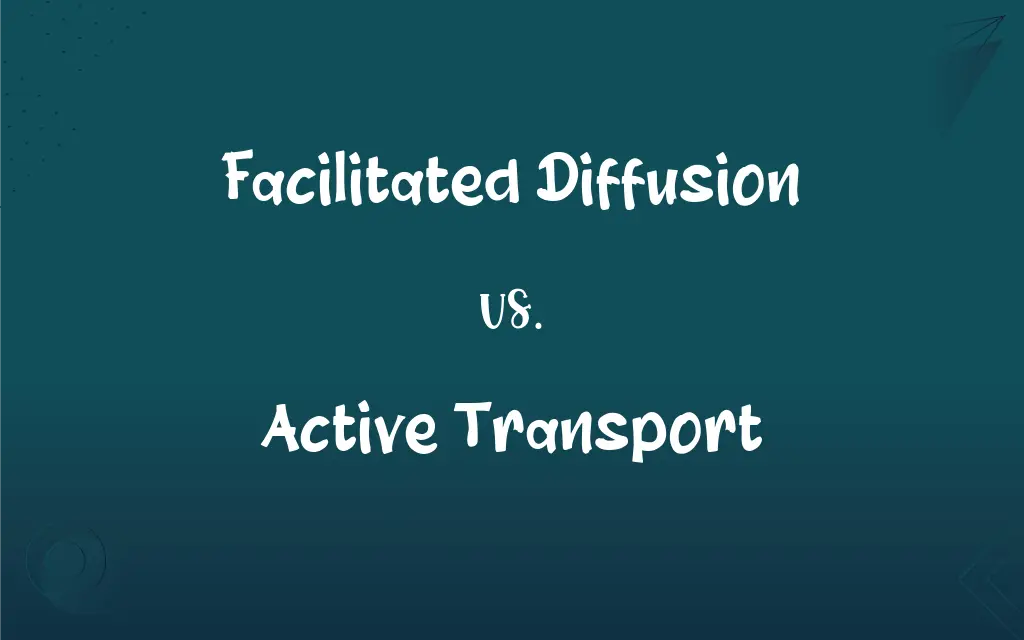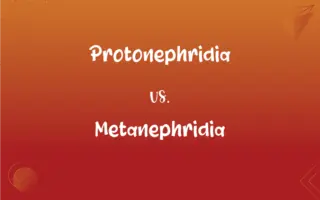Facilitated Diffusion vs. Active Transport: What's the Difference?
Edited by Aimie Carlson || By Janet White || Published on August 8, 2024
Facilitated diffusion moves substances across cell membranes without energy, using concentration gradients, whereas active transport requires energy to move substances against their gradient.

Key Differences
Facilitated diffusion is a passive transport mechanism used by cells to move molecules across the cell membrane through specific protein channels or carriers without the use of energy. It relies on the concentration gradient of the molecule, moving substances from areas of high concentration to areas of low concentration. Active transport, in contrast, is an energy-requiring process where cells move molecules against their concentration gradient, from areas of low concentration to areas of high concentration, using ATP (adenosine triphosphate) as an energy source.
Facilitated diffusion is characterized by its specificity, as the protein channels or carriers are specific to the type of molecules they transport. This process allows cells to regulate the internal concentration of various substances efficiently. Active transport, on the other hand, not only requires energy but also involves specific transport proteins that can move a wide variety of ions and molecules across cell membranes, enabling cells to maintain internal concentrations of substances that are different from their external environment.
An essential feature of facilitated diffusion is that it cannot move molecules against their concentration gradient, a limitation that does not apply to active transport. Active transport mechanisms, such as the sodium-potassium pump, are fundamental for many cellular processes, including nerve impulse transmission and muscle contraction, where ions are moved against their concentration gradient.
Facilitated diffusion is driven purely by the concentration gradient of the transported substance and does not involve the direct use of cellular energy, active transport is crucial for cells to acquire necessary substances and expel waste products against their concentration gradients. This energy-dependent process is vital for maintaining the appropriate conditions within cells for metabolic activities.
Both facilitated diffusion and active transport are critical for the survival of cells, allowing them to import nutrients and export wastes. However, their mechanisms of action, energy requirements, and directions of substance movement distinctly differ, reflecting the complexity and specificity of cellular transport processes.
ADVERTISEMENT
Comparison Chart
Energy Requirement
No energy required
Requires ATP or another form of energy
Direction of Transport
With the concentration gradient
Against the concentration gradient
Transport Proteins
Uses specific channels or carriers
Uses specific pumps and carriers
Substances Transported
Usually ions and small molecules
Ions, small molecules, and larger substances
Role in Cellular Processes
Balances internal concentrations passively
Maintains essential gradients actively
ADVERTISEMENT
Facilitated Diffusion and Active Transport Definitions
Facilitated Diffusion
Movement of substances across cell membranes without energy expenditure.
Glucose uses facilitated diffusion to move into cells where it's needed for energy.
Active Transport
Energy-dependent transport of substances across membranes.
Active transport is essential for absorbing nutrients in the intestines against their concentration gradient.
Facilitated Diffusion
Passive cellular transport mechanism for specific molecules.
Facilitated diffusion allows potassium ions to move out of cells, maintaining electrical neutrality.
Active Transport
Mechanism using ATP to transport molecules across cell membranes.
Calcium ions are pumped out of muscle cells by active transport during muscle relaxation.
Facilitated Diffusion
Transport process utilizing protein channels for molecule passage.
Ions pass through the cell membrane by facilitated diffusion, balancing charges.
Active Transport
Transport process requiring energy for moving substances uphill.
Active transport enables root cells to absorb minerals from the soil against low concentrations.
Facilitated Diffusion
The diffusion of molecules aided by membrane proteins.
Water moves into the cell through aquaporins via facilitated diffusion.
Active Transport
Cellular process that moves molecules against their gradient using energy.
The sodium-potassium pump uses active transport to maintain cellular ion balance.
Facilitated Diffusion
Passive transport of molecules through a membrane via specific proteins.
Oxygen entering a cell through facilitated diffusion is crucial for respiration.
Active Transport
Energy-utilizing process to move ions and molecules selectively.
Neurotransmitters are recycled in synaptic clefts through active transport.
FAQs
What is facilitated diffusion?
A passive transport process using protein channels to move molecules across membranes without energy.
How do cells use facilitated diffusion?
To passively transport ions and small molecules across the membrane.
What defines active transport?
The movement of substances against their concentration gradient using energy.
What types of molecules are typically transported by facilitated diffusion?
Ions and small polar molecules.
How does active transport contribute to nerve function?
By maintaining ion gradients necessary for nerve impulse transmission.
Can facilitated diffusion move molecules against the gradient?
No, it only moves molecules along the concentration gradient.
Why is active transport important for cells?
It enables cells to maintain concentration gradients essential for various functions.
Is facilitated diffusion selective?
Yes, it requires specific proteins for each molecule type.
What's an example of a substance transported by active transport?
Sodium ions are actively pumped out of cells.
Are protein channels involved in active transport?
Yes, but as specific pumps and carriers that require energy.
Does active transport require a membrane?
Yes, substances are moved across cellular or organelle membranes.
Can facilitated diffusion and active transport work together?
Yes, they often operate simultaneously to regulate cell composition.
What energy source does active transport use?
ATP or other forms of cellular energy.
What role does ATP play in active transport?
It provides the energy needed to move substances against their gradient.
How does facilitated diffusion affect cell homeostasis?
It helps maintain the balance of essential molecules and ions.
What determines the direction of movement in facilitated diffusion?
The concentration gradient of the substance.
Are all cells capable of active transport?
Yes, all cells have mechanisms for active transport.
How do concentration gradients affect facilitated diffusion?
The process stops once equilibrium is reached.
Can facilitated diffusion operate without membrane proteins?
No, it depends on specific channels or carriers.
How does the body use active transport in nutrient absorption?
Active transport mechanisms in the intestines allow for the uptake of nutrients against their concentration gradients.
About Author
Written by
Janet WhiteJanet White has been an esteemed writer and blogger for Difference Wiki. Holding a Master's degree in Science and Medical Journalism from the prestigious Boston University, she has consistently demonstrated her expertise and passion for her field. When she's not immersed in her work, Janet relishes her time exercising, delving into a good book, and cherishing moments with friends and family.
Edited by
Aimie CarlsonAimie Carlson, holding a master's degree in English literature, is a fervent English language enthusiast. She lends her writing talents to Difference Wiki, a prominent website that specializes in comparisons, offering readers insightful analyses that both captivate and inform.






































































